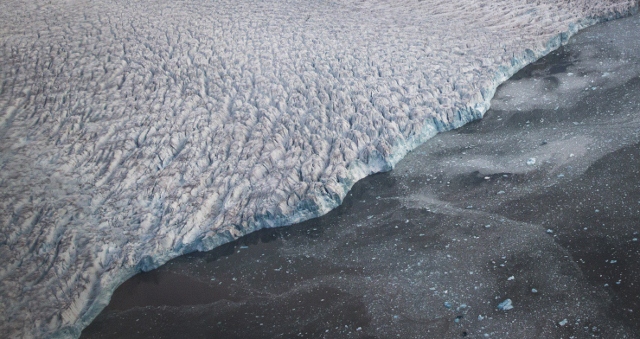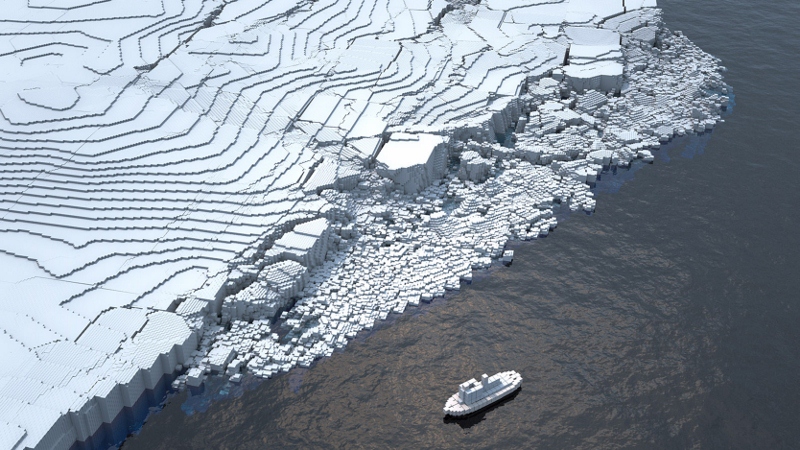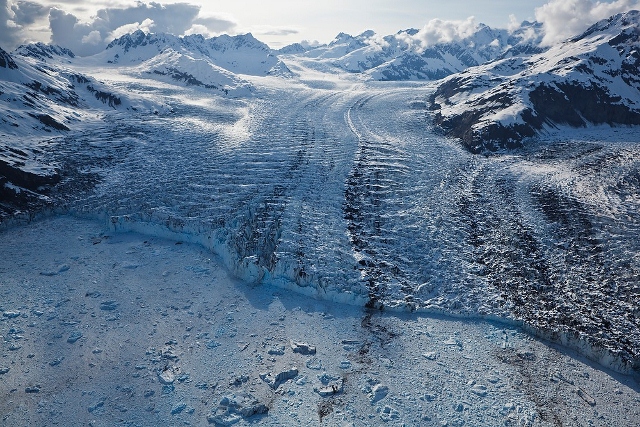Why glaciers that flow into the ocean are extremely sensitive to climate
by Dorothée Vallot
Rising seas are among the greatest threats posed by climate change. Over the next century, ice sheets and glaciers will contribute significantly to sea level rise through melting and “calving” (breaking off) of ice into the ocean. Observed rates of iceberg calving are not easy to reproduce in computer simulations, and due to their rapid and non-linear fluctuations, are especially calving fluxes difficult to predict under a changing climate. Robust simulation of iceberg calving, and therefore more precise projections of sea level rise, remains one the grand challenges in preparing for a warming world.
"In this study, we compared extensive observations of iceberg calving from Svalbard, Alaska, Greenland, and Antarctica to theoretical developments and advanced computer simulations” explained Dr. Jan Åström of the CSC – IT Centre for Science in Finland.


Picture 1a,b: Kronebreen, Svalbard in September 2014 (Photo by co-author D. Vallot) and simulated by the authors’ computer model (graphics by J. Hokkanen, CSC).
"We found that the frequency of observed calving events, ranging from 1 to 1 trillion m3, follow universal scaling laws. This means that the probability of calving events obey a particular pattern no matter if they are small or large events – much like the Gutenberg-Richter law for earthquakes. The observations also agree with our computer simulations, where we model calving events as the fracture of millions of individual ice blocks. Cracks will suddenly propagate through the ice blocks, triggering calving events whose size and inter-event time distributions share a striking resemblance to those predicted by a classic theory of self-organised criticality, originally developed as a model of a growing sandpile [the Abelian sandpile model]."
Their results suggest that calving glaciers and ice sheets behave as self-organised critical systems that fluctuate around a critical point, readily flipping between states of sub-critical advance and super-critical retreat in response to changes in climate and geometric conditions.
This means that calving is extremely and unavoidably sensitive to its environment: a slight climate change can mean the difference between very little calving and the complete disintegration of entire ice shelves.
This new view of iceberg calving explains the observed, sudden collapse of ice shelves and sudden retreat of tidewater glaciers as the polar regions slowly warm. The authors suggest that their results and theoretical framework will guide improvements in our ability to estimate future sea levels.

Picture 2: Aerial view from 2010 of the west branch of Columbia Glacier, a rapidly retreating tidewater glacier in Alaska. The water in front of the glacier is littered with calved chunks of ice of a wide range of sizes. Photo by co-author E.Z. Welty.
The study is a Finnish-Swedish-US-Chinese collaboration and has just been published in the journal Nature Geoscience as:
Åström, J.A., D. Vallot, M. Schäfer, E.Z. Welty, S. O'Neel, T.C. Bartholomaus, Y. Liu, T.I. Riikilä, J. Timonen, T. Zwinger and J. C. Moore (2014). Termini of calving glaciers as self-organised critical systems, Nature Geoscience. Available online at dx.doi.org/10.1038/ngeo2290.
The partners are:
Finland – CSC–IT Centre for Science, University of Lapland Arctic Center, Finnish Meteorological Institute, University of Jyväskylä Nanoscience Center and Department of Physics. Sweden – Uppsala University Department of Earth Science. United States – University of Colorado Institute of Arctic and Alpine Research, U.S. Geological Survey Alaska Science Center, University of Texas Institute for Geophysics. China – Beijing Normal University College of Global Change and Earth System Science.
The full abstract of the journal article:
Over the next century, one of the largest contributions to sea level rise will come from ice sheets and glaciers calving ice into the ocean. Factors controlling the rapid and nonlinear variations in calving fluxes are poorly understood, and therefore difficult to include in prognostic climate-forced land-ice models. Here we analyse globally distributed calving data sets from Svalbard, Alaska, Greenland and Antarctica in combination with simulations from a first-principles, particle based numerical calving model to investigate the size and inter-event time of calving events. We find that calving events triggered by the brittle fracture of glacier ice are governed by the same power-law distributions as avalanches in the canonical Abelian sandpile model. This similarity suggests that calving termini behave as self-organized critical systems that readily flip between states of sub-critical advance and super-critical retreat in response to changes in climate and geometric conditions. Observations of sudden ice-shelf collapse and tidewater glacier retreat in response to gradual warming of their environment are consistent with a system fluctuating around its critical point in response to changing external forcing. We propose that self-organized criticality provides a yet unexplored framework for investigations into calving and projections of sea level rise.
Contact info:
Dorothée Vallot – +46 7 20 01 61 30,
Department of Earth Science, Uppsala University, Sweden
www.geo.uu.se
|